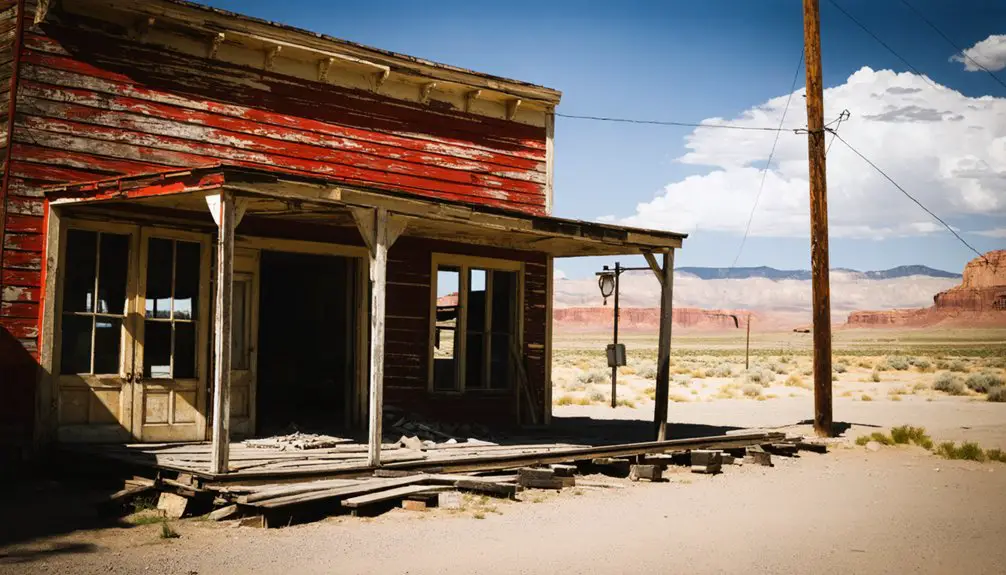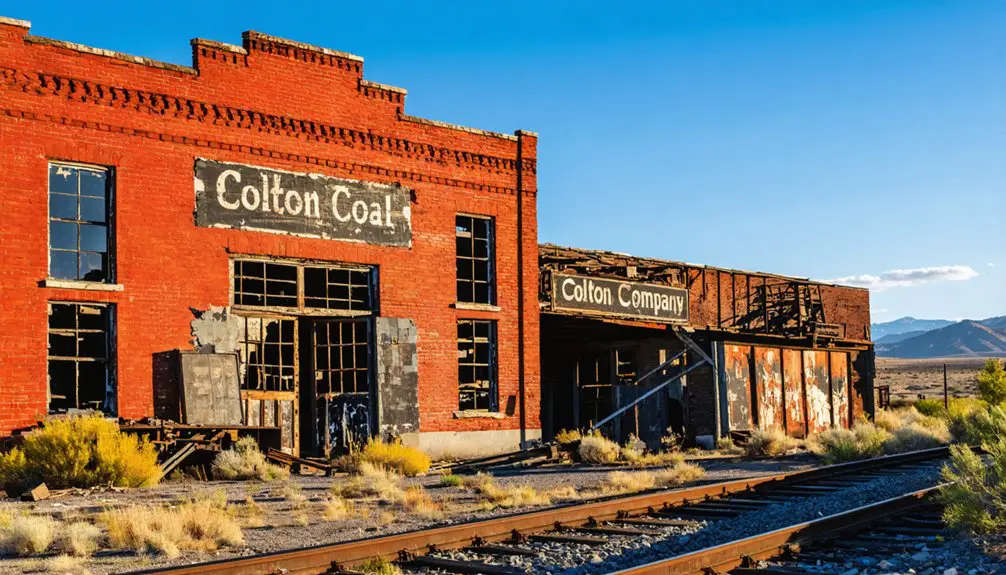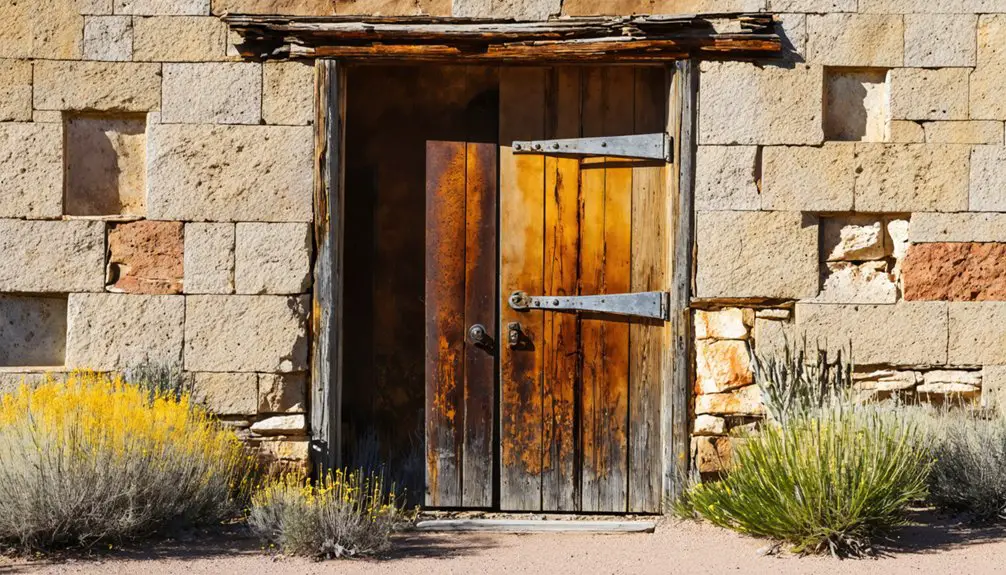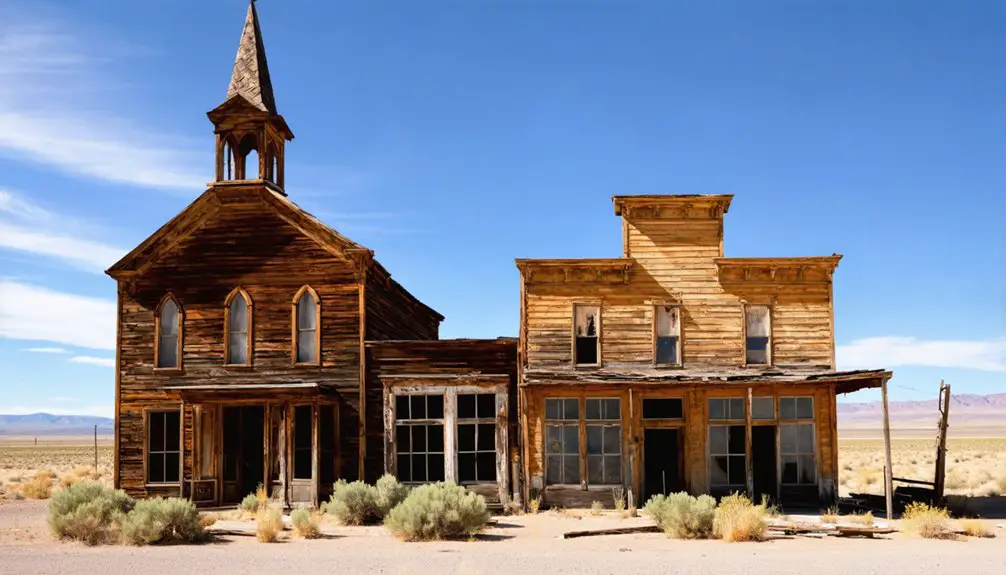You’ll find Colton’s ghost town remains in Utah’s Carbon County, where it began as Pleasant Valley Junction in 1882. This Denver & Rio Grande Western Railroad hub connected mainline tracks to Scofield’s coal mines, featuring a roundhouse, turntable, and bustling commercial district. The town thrived until the 1950s when diesel engines replaced steam locomotives. Today, the historic Hilltop Country Store stands as the most visible reminder of Colton’s railroad glory days, with more secrets waiting in the surrounding hills.
Key Takeaways
- Colton was established in 1882 as Pleasant Valley Junction, serving as a crucial railroad hub connecting main lines to Utah’s coal mines.
- The town featured a complete railroad complex including roundhouse, turntable, depot, and multiple businesses serving the railroad community.
- Decline began in the 1950s when railroads switched to diesel engines, eliminating Colton’s importance as a steam locomotive service point.
- Today, the Hilltop Country Store remains as the most visible structure, containing vintage photographs and memorabilia of Colton’s past.
- The ghost town site is accessible via two-wheel drive roads, with a few scattered ruins and buildings remaining from its railroad heyday.
The Birth of Pleasant Valley Junction
As the Denver & Rio Grande Western Railroad expanded through central Utah in the early 1880s, they established Pleasant Valley Junction as an essential railhead where their main line connected to a branch serving the coal mines of Scofield and Winter Quarters.
The railroad origins of this settlement, founded in late 1882 or early 1883, quickly sparked development with the construction of a roundhouse, turntable, and workers’ bunkhouses. Local businesses like hotels and saloons emerged to serve the growing railroad community. Much like the distinct communities of Colton in England, this Utah settlement developed its own unique character and local governance.
You’ll find this historic site near the Utah-Carbon County line, along today’s U.S. Highway 6 south of SR 96.
The town’s naming history reflects its evolution – what started as Pleasant Valley Junction transformed into Colton around 1898, honoring railroad official William F. Colton as the settlement grew from a simple rail siding into a proper town.
Rail Hub at the Heart of Utah
When you visit modern-day Colton, it’s hard to imagine that this quiet spot once served as a critical railroad junction where the Denver & Rio Grande Western’s mainline met branch routes to the coal mines of Scofield and Winter Quarters.
You’d have found a complete railroad support complex in 1882, including a roundhouse, turntable, depot, and workers’ bunkhouses, all positioned to handle the steady stream of coal and ozokerite shipments flowing through Price Canyon.
Life along these tracks bustled with activity as two hotels, saloons, and various businesses sprang up to serve both railroad workers and local ranchers who used the hub’s large livestock corral for cattle shipments. Originally called Pleasant Valley Junction, the town was renamed to Colton in 1898. The Denver & Rio Grande continued operating the line until 1917 when Utah Railway took over operations due to widespread dissatisfaction with D&RG’s service quality.
Strategic Railroad Junction Location
The strategic placement of Colton at Pleasant Valley Junction emerged as a significant railroad hub in late 1882 when the Denver & Rio Grande Western Railroad established the settlement. Originally named Pleasant Valley Junction, its railroad significance stemmed from its position at the convergence of major rail lines connecting the coal mines of Scofield and Winter Quarters to the main Rio Grande route.
You’ll find this junction history deeply rooted in Utah’s industrial development, as Colton sat perfectly positioned near the Carbon and Utah County border along U.S. Highway 6. The town was later renamed to honor William F. Colton, a prominent railroad official.
The location’s natural advantages included the meeting point of Price and White rivers, plus reliable springs that supplied essential water for operations. The site proved ideal for shipping both coal and cattle, serving as a critical railhead during the completion of the Price Canyon line in 1882-1883.
Bustling Railroad Support Operations
Building upon its strategic location, Colton rapidly evolved into a bustling rail hub with extensive support facilities by the late 1880s.
Railroad expansion transformed the simple siding into a thorough complex featuring a roundhouse, turntable, depot, and workers’ bunkhouses. By the 1890s, you’d find two large hotels and a thriving business district along the tracks.
The hub’s freight operations served multiple industries. You could spot local ranchers driving cattle to the large trackside corral for shipment to market.
The Denver & Rio Grande Western‘s branch lines connected Pleasant Valley and Winter Quarters coal mines to Colton’s main network. When ozokerite mining began in 1904, the Utah Ozokerite Company’s mill added to the steady flow of mineral shipments that kept Colton’s rail facilities bustling for decades.
Life Along The Tracks
Nestled between Utah and Carbon counties, Colton emerged as more than just a rail stop – it became a vibrant community shaped by the rhythms of railroad life.
You’d find a bustling railroad community where two grand hotels and numerous saloons served both transient workers and travelers passing through. The stone schoolhouse stood as a symbol of the town’s family-oriented spirit, while nearby springs provided essential water for daily life.
Despite rebuilding three times after devastating fires, Colton’s residents maintained their resilient spirit.
The mix of bunkhouses, businesses, and community structures created a typical Western atmosphere where ranch hands, railroad workers, and families shared the same streets. Fresh water from natural springs and the constant flow of goods and people kept this rail hub alive until modern changes eventually led to its decline.
Mining Adventures in Ozokerite
During the fall of 1904, prospectors struck upon a rare mineral treasure in Colton, Utah – ozokerite, a naturally occurring wax that would soon attract significant industrial interest.
Similar to how local farmers created small coal mines to meet their own needs in Utah’s early days, C.L. “Gunplay” Maxwell and lawyer Mark P. Braffet quickly established the Utah Ozokerite Company, developing what would become the world’s largest ozokerite mine.
Under superintendent H.H. Miller‘s direction, miners worked two shifts, digging shafts over 70 feet deep with multiple drifts.
Life in a Bustling Railroad Town

While ozokerite mining brought new prospects to the area, it was the railroad that first established Colton’s identity.
You’d find yourself in a vibrant community where steam locomotives rumbled through daily, with railroad workers bustling around the roundhouse, turntable, and depot. The town’s business district thrived along the tracks, offering you multiple saloons and two hotels for entertainment and lodging.
If you’d lived there in the late 1800s, you’d have joined a close-knit community of over 400 residents. Your children would’ve attended the stone schoolhouse, while community gatherings often centered around the railroad’s schedule. The Hilltop General Store, established in 1880, served as a central gathering place for the townspeople.
Despite surviving fires and rebuilding multiple times, the town’s spirit remained unshakeable until the 1950s, when diesel engines made the helper station unnecessary.
Architectural Heritage and Infrastructure
Three distinct architectural zones defined Colton’s layout: the railroad district with its roundhouse and turntable, the commercial corridor featuring two hotels and various businesses, and the residential area anchored by the stone schoolhouse.
The town’s architectural styles reflected both necessity and purpose, with buildings constructed from local materials to serve the bustling railroad and mining operations. The vibrant commercial district included five bustling saloons during its peak years.
You’ll find evidence of the infrastructure evolution through these remaining features:
- Wood-frame structures dominated the railroad zone, including worker bunkhouses.
- Fire-resistant brick and wood combinations in hotels after multiple rebuilds.
- Local stone construction in the schoolhouse, showcasing civic investment.
- Utilitarian designs prioritizing function over decoration in industrial areas.
The town’s decline paralleled the shift from steam to diesel locomotives, leaving only ruins and the relocated Hilltop Country Store as relics to Colton’s heyday.
The Economic Powerhouse Years

Colton’s rise as an economic powerhouse began in 1883 when the Denver & Rio Grande Western Railroad established Pleasant Valley Junction, transforming a remote mountain location into an essential transportation hub.
You’ll find the town’s historical significance rooted in its strategic position, where railroad infrastructure facilitated coal transport from Winter Quarters and Scofield mines.
Events Leading to Abandonment
You’ll find that Colton’s decline began when the Denver & Rio Grande Western Railroad shifted away from steam locomotives to diesel engines in the 1950s, eliminating the town’s essential role as a helper station.
The mining industry’s collapse dealt another blow, as both the devastating 1900 Scofield disaster and the declining demand for ozokerite by the late 1940s removed the town’s economic foundations.
Like many railroad towns that emerged during the era of steam locomotives, Colton’s fate was sealed by technological advancement and shifting transportation priorities.
The final nail came when railroad officials chose Soldier Summit over Colton as a division point in 1915, redirecting critical railroad investment and traffic away from the once-bustling hub.
Railroad Operations Shift
During the 1950s, a major technological shift from steam to diesel locomotives dramatically altered Colton’s role as an essential railroad hub. The new railroad technology made helper engines unnecessary for conquering Soldier Summit’s steep grades, and operational efficiency improvements meant fewer stops were needed along the route.
- You’d no longer see steam locomotives being serviced at the once-bustling roundhouse.
- The iconic turntable that positioned engines now stood silent and unused.
- Helper engines that once assisted trains up steep grades disappeared from the landscape.
- The depot’s busy platforms grew quiet as fewer trains stopped at the station.
D&RGW’s modernization led to the dismantling of Colton’s steam-era infrastructure, while improved routes and division points handled traffic more efficiently elsewhere.
The town’s strategic importance faded as railroad operations shifted to match the capabilities of diesel power.
Mining Industry Collapse
While Utah’s coal mining industry had weathered many challenges since the 1900s, a perfect storm of economic pressures in the 1920s marked the beginning of its decline.
You’d see the effects of inferior coal quality from mines like Winter Quarters, coupled with expensive underground haulage that made extraction costs soar beyond profitability. The nationwide mining depression didn’t help.
Labor unrest intensified as devastating disasters – from the 1900 Winter Quarters explosion that killed 200 to the 1924 Castle Gate tragedy claiming 171 lives – pushed miners toward unionization.
When railroads switched to diesel and homeowners embraced natural gas heating, the mining decline accelerated.
The final blow came with the 2007 Crandall Canyon disaster, where dangerous geological conditions led to nine deaths and the mine’s permanent closure. The collapse triggered a 3.9 magnitude earthquake that shook the region and signaled the catastrophic underground failure.
What Remains Today

Today in Colton, Utah, visitors will find the prominent Hilltop Country Store standing as the most visible reminder of this former railroad town‘s past.
While most remaining structures have vanished since the 1950s, you’ll still discover a handful of current residents maintaining properties near the historic site, located just 6 miles south of Soldier Summit along Highway 6.
- The weathered Country Store, relocated closer to the highway in 1937, houses vintage photographs and memorabilia behind its closed doors.
- A few intact buildings and ruins dot the original townsite, accessible via two-wheel drive roads.
- Nearby springs continue flowing with clear mountain water, just as they did in the 1880s.
- The surrounding environment offers cool winters with snow and warm summers typical of the Utah-Carbon County border region.
Frequently Asked Questions
Are There Any Paranormal Activities Reported in the Abandoned Buildings of Colton?
You won’t find documented ghost sightings in Colton’s buildings. While paranormal investigations occur in nearby Carbon County towns like Helper, there’s no confirmed paranormal activity specifically in Colton’s abandoned structures.
What Was the Highest Recorded Population of Colton During Its Peak?
During the mining boom, you’d find 427 people living there at its height in 1890, but you’ll see the stark population decline hit hard after that, dropping to just 107 residents by 1900.
Did Any Famous Historical Figures Ever Visit or Stay in Colton?
While famous visitors were rare, your most notable historical figure was Clarence “Gunplay” Maxwell, who briefly stayed in 1904 while mining ozokerite before continuing his notorious criminal career in the West.
Can Visitors Legally Explore and Photograph the Remaining Structures Today?
You can legally explore and photograph the remaining structures from public access points, following standard exploration guidelines. Just don’t trespass on private land or remove artifacts while capturing images.
Were There Any Major Crimes or Notable Lawless Incidents in Colton?
Like a tumbleweed drifting through town, crime history in Colton remains surprisingly sparse. You won’t find major documented lawless incidents, though “Gunplay” Maxwell’s presence and five saloons hint at typical frontier disorder.
References
- https://www.legendsofamerica.com/ut-colton/
- https://kids.kiddle.co/Colton
- https://en.wikipedia.org/wiki/Colton
- https://beyond.nvexpeditions.com/utah/utah/colton.php
- https://en.wikipedia.org/wiki/Kelton
- https://jacobbarlow.com/2014/07/14/pleasant-valley-junction/
- https://utahrails.net/utahcoal/pleasant-valley.php
- https://utahrails.net/utah-ry/utah-ry-history.php
- https://utahrails.net/utahrails/upv-1875-1881.php
- https://onlineutah.us/coltonhistory.shtml



